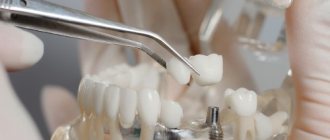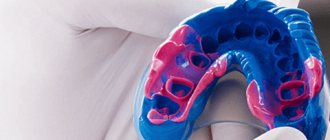From this article you will learn:
- what antibiotics are used for inflammation of the gums, tooth roots, gumboil,
- choice of antibiotic and dosage regimen,
- is it possible to give injections in the gums,
- causes of diarrhea after taking antibiotics.
The article was written by a dental surgeon with more than 19 years of experience.
Antibiotics are medicines that have antimicrobial properties and inhibit the growth and reproduction of pathogenic microorganisms. In dentistry, antibiotics are most often prescribed either for inflammation of the gums or for apical periodontitis (i.e., in the treatment of purulent inflammation at the apex of the tooth root). In each of these cases, inflammation is caused by different types of pathogenic bacteria and/or microbial associations, which requires the correct choice of drug before starting antibacterial therapy in the oral cavity.
In most cases, antibiotics in dentistry are prescribed “empirically”, i.e. without preliminary microbiological examination. Therefore, the dentist must be familiar with the likely composition of the microflora in the source of inflammation in various dental diseases (periodontitis, periodontitis, gumboil on the face), and also be aware of current data on the resistance of pathogenic bacteria to various types of antibiotics. Therefore, part 1 of our article will be devoted to what antibiotics are needed for gum gum disease and the development of purulent inflammation at the root of the tooth, and the second part will be devoted to how to choose the optimal antibiotic for gum inflammation (i.e., chronic generalized periodontitis).
Important: the treatment regimens described below are for informational purposes only, because An attempt to relieve inflammation without going to the dentist always leads to only a temporary improvement, but a more aggressive course of inflammation in the future. Therefore, we recommend taking antibiotics only as prescribed by a doctor!
What is tooth flux?
Flux, or, in dentist's language, periostitis, is a very unpleasant pathology, which is characterized by inflammation of the periosteum and soft tissues. The causes of flux on the gums can be different: trauma, gum disease, poor-quality dental treatment - all this can lead to a complication in the form of periostitis. The localization of the disease does not depend on the area of the jaw: flux of the upper and lower teeth occurs equally often.
Flux under a tooth (or above a tooth, if we are talking about the upper jaw) visually resembles an inflamed sac. However, this is far from the only possible manifestation of periostitis. There is also a serous form, when the periosteum becomes inflamed as a result of trauma and damage, as well as one of the most unpleasant types - diffuse, when the infection is localized in different parts of the jaw, which requires extensive surgical intervention with the participation of a maxillofacial surgeon.
Propolis tincture
Propolis tincture has a strong anti-inflammatory effect and wound healing effect. Tannins relieve pain well. And essential oils and flavonoids are powerful natural antibiotics. To treat gumboil, 15 ml of propolis tincture is diluted in half a glass of warm boiled water. The solution is used for rinsing. You can moisten a cotton pad with undiluted tincture and apply it to the inflamed area overnight.
Treating flux with propolis in its natural form is also effective. It must be chewed throughout the day until the toothache disappears.
Propolis tincture can be purchased at a pharmacy or prepared at home yourself. To do this, 20 g of propolis is finely crushed and filled with 100 ml of 70% medical ethyl alcohol. Infused in a dark glass bottle for 14 days.
Symptoms of gumboil
Flux on the gums in adults occurs much more often than in children (approximately 80-90 percent of all cases). A characteristic feature of the pathology is that it does not go unnoticed. This is one of the most unpleasant diseases, causing severe discomfort. The most striking symptoms are the classic purulent flux.
Symptoms
- Severe throbbing pain.
- Inflammation and swelling of soft tissues. At the advanced stage, the side of the face on which the flux is diagnosed swells.
- Enlarged lymph nodes.
- Discomfort and pain when eating and talking.
- Flux of the lower tooth (in the molar area) can lead to numbness of the lip and part of the chin.
- Weakness, headache, fever.
How not to cause harm?
What to do if flux appears? Some patients mistakenly believe that swelling and severe toothache can be relieved on their own with the help of warming compresses, herbal infusions and other folk remedies. Unfortunately, such health experiments often end very badly. Thus, in order not to inadvertently harm yourself and provoke further development of the disease, the following contraindications should be observed:
- No warming compresses that contribute to the spread of periostitis.
- Never take painkillers less than 3 hours before visiting the dentist. Otherwise, you can significantly complicate the diagnosis process.
- After opening a purulent lesion, you should not take aspirin. It can provoke bleeding, especially since it is completely useless as a pain reliever in this case.
- If your condition has not improved 12 hours after surgery, you should see your doctor again.
How many days does tooth flux last?
Waiting for the flux to disappear on its own is, to say the least, naive. Some patients believe that if the flux bursts and pus comes out of the wound, then further treatment may not be carried out at all. This is a big mistake, since complete removal of pus requires special drainage, as well as complex therapy and subsequent treatment in the dentist’s chair. With timely and correct treatment, the flux disappears on average in 12-14 days; rehabilitation after severe periostitis can take more than a month.
Diagnostics
Before proceeding with dental flux treatment, the doctor must conduct an appropriate diagnostic examination. The exact diagnosis is determined based on data obtained during a clinical examination and x-ray diagnosis. Laboratory tests allow you to accurately determine the stage of the inflammatory process. Only after making an accurate diagnosis will a specialist be able to decide what to do with gumboil and which method of treatment in this particular case will be optimal.
Treatment methods
The attending physician should tell you after the examination how to treat gumboil and what measures need to be taken to achieve a successful result. The mechanism is approximately the same, but each clinical case has its own nuances. Today, several techniques are used aimed at eliminating the disease and its manifestations. As a rule, they come together.
Antibiotics for gumboils
Antibiotic treatment is an important stage of rehabilitation. The most effective antibiotics for fighting inflammation and infection are Metronidazole, Lincomycin, Amoxiclav and their analogues. Any tablets and antibiotics for tooth flux should be taken only as prescribed by a doctor!
Physiotherapy
Used as an additional measure to reduce inflammation and speed up recovery. Recommended procedures include electrophoresis, laser and ultrasound therapy.
Therapeutic treatment
It is carried out if it is decided to save the tooth. This includes endodontic treatment and filling of root canals, as well as resection of the root apex if necessary. If the cause of the flux is periodontitis, then a series of manipulations are carried out to eliminate the accumulation of bacteria in the periodontal pockets.
Surgical procedures
This includes tooth extraction and periostotomy - the main procedure for treating flux. The doctor makes an incision into the purulent sac, and then installs a drain through which the purulent exudate comes out.
Local therapy and rinsing for tooth flux
For better release of pus, pain relief and reduction of swelling, gels and ointments are used topically: Metrogyl Denta, Levomekol, Cholisal. Many people are interested in how to rinse gumboil on the gums. Miramistin and soda solution are usually used for rinsing. As an alternative, you can use folk remedies: decoctions and tinctures of propolis, chamomile, sage or calendula. A tooth after gumboil is still very vulnerable: to minimize the risk of re-infection, these treatment and preventive procedures are very important.
Sage
Sage essential oils have pronounced anti-inflammatory and antibacterial effects. At the first signs of periostitis, you need to brew 60 g of sage leaves and 2 tablespoons of oak bark with boiling water, let it brew for 20-30 minutes in a warm place or in a water bath. Rinse your mouth with the prepared solution at least 8-10 times a day.
No less effective is an infusion of sage and iris roots, for the preparation of which you need to mix 50 g of each component. Pour 2 tablespoons of the mixture with boiling water and leave for half an hour to infuse. Rinse your mouth with the resulting product every hour until the pain decreases.
Is a tooth removed during gumboil?
A tooth can be removed due to flux, but in modern dentistry the emphasis is on tooth-preserving manipulations. This also applies to flux. A tooth must be removed when its crown is seriously damaged and cannot be restored with a pin or inlays. If an infection occurs under the crown, then re-prosthetics are often difficult. In some cases, a tooth has to be removed because it is impossible to unfill the canals after a previous unsuccessful treatment, but this happens extremely rarely. In any case, the doctor makes the decision to remove a tooth based on the clinical picture.
Anti-inflammatory drugs
You can quickly relieve swelling and reduce pain at home with flux using anti-inflammatory non-steroidal drugs. They are available in the form of tablets, suspensions, and powders.
"Nimesil"
The main anti-inflammatory “dental” remedy. The main component is nimesulide. It has a strong anti-edematous, anti-inflammatory effect, and to a lesser extent – antipyretic and analgesic. These properties make Nimesil the No. 1 drug in the treatment of periostitis.
The main component is nimesulide.
The medicine is prescribed for adults and children over 12 years of age, 1 sachet twice a day. It is not recommended for patients with disorders of the intestines, liver, heart or during pregnancy.
The price of one sachet of “Nimesil” is 20–30 rubles.
Why is tooth flux dangerous?
An inflammatory process of this type tends to develop and, as it spreads, affects deeper layers of tissue. If left untreated, flux often develops into phlegmon - a serious purulent inflammation that has no definite boundaries. The most severe forms of flux provoke the development of sepsis, which can lead to infection of the entire body and even death. It is important not only to know how to cure gumboil and visit the dentist on time, but also to follow a number of preventive measures so that the likelihood of complications developing is minimal.
- Regular and high-quality hygiene.
- Treatment of caries at the initial stage. Flux, dental cysts and other complications often arise due to untreated pulpitis and periodontitis.
- Preventative visits to the clinic to assess the condition of the oral cavity and carry out professional cleaning.
Causes
Inflammatory (infectious-inflammatory) diseases of the maxillofacial area are caused by microbial microorganisms, which are usually part of the normal microflora of the oral cavity. Microbial pathogens are staphylococci, streptococci, enterococci, diplococci, gram-positive and gram-negative bacilli (intestinal, protea, etc.). In addition, during flux, fungi, mycoplasmas, treponema, and protozoa from the Trichomonas family are found in foci of odontogenic infection. According to various authors who analyzed the microbial flora in foci of odontogenic infection (flux), the microflora is represented by a monoculture of staphylococcus (aurus and epidermal) or streptococcus of groups D, F and G. Associations of the above microorganisms are often identified.
The question arises of how non-pathogenic or opportunistic microorganisms trigger the initiation of an infectious-inflammatory process (flux). For the occurrence of a disease, the presence of only non-pathogenic or pathogenic microorganisms is not enough. The answer to this question is given by the so-called Arthus-Sakharov phenomenon. According to the infectious-allergic theory, its essence boils down to the following: under the influence of a foreign serum protein, which has antigenic properties, antibodies are produced, which leads to sensitization of the body. Sensitization of the body is the acquisition by the body of increased sensitivity to foreign substances (proteins) - allergens. Against this background, repeated introduction of the protein into the vascular bed causes the formation of antigen + antibody complexes, which are fixed on the membranes of blood vessels and turn into target cells. Then the cell membrane is damaged, enzymes are released, mediators (from the Latin mediator - mediator) of inflammation are released. This is accompanied by activation of the third platelet factor and can cause intravascular coagulation, which leads to impaired microcirculation and necrosis (death) of tissue. This immunopathological reaction is also involved in odontogenic infection, leading to the occurrence of gumboil. The waste products of microbes participate in the role of antigen. This explains why in many patients non-pathogenic microorganisms are found at the site of inflammation.
The dynamic balance between the focus of chronic odontogenic infection and the body is ensured by the connective tissue capsule surrounding the focus. It limits the penetration of microbes into the tissues and vascular bed adjacent to the lesion, and limits the effect of immune factors on the infectious focus. The balance is also maintained by the fact that part of the waste products of microorganisms and tissue decay through the root canal of the tooth, fistula or periodontal fissure is released from the infectious focus into the oral cavity.
An imbalance can be caused by a disruption in the outflow of exudate from the lesion through the root canal due to food masses entering the carious cavity or when filling a carious cavity by a dentist. In the infectious focus, the concentration of microbes, their toxins, and waste products, which penetrate through the connective tissue capsule into the surrounding tissues, increases. Here their direct damaging effect on tissue can occur, and upon penetration into the vascular bed, the mechanism of the Arthus-Sakharov phenomenon is triggered. Clinically, this is manifested by an exacerbation of a chronic focus of odontogenic infection and the occurrence of gumboil.
Another mechanism of imbalance between the focus of chronic infection and the human body is associated with damage to the connective tissue capsule itself. This can happen when a tooth is removed, when there is increased load on the tooth while chewing hard food, etc. Damage to the capsule leads to the spread of microorganisms (their toxins, waste products) beyond the infectious focus, which in a sensitized organism leads to the occurrence of the Arthus-Sakharov phenomenon. These are the reasons and the main mechanism of exacerbation of odontogenic infection, leading to the development of gumboil.











